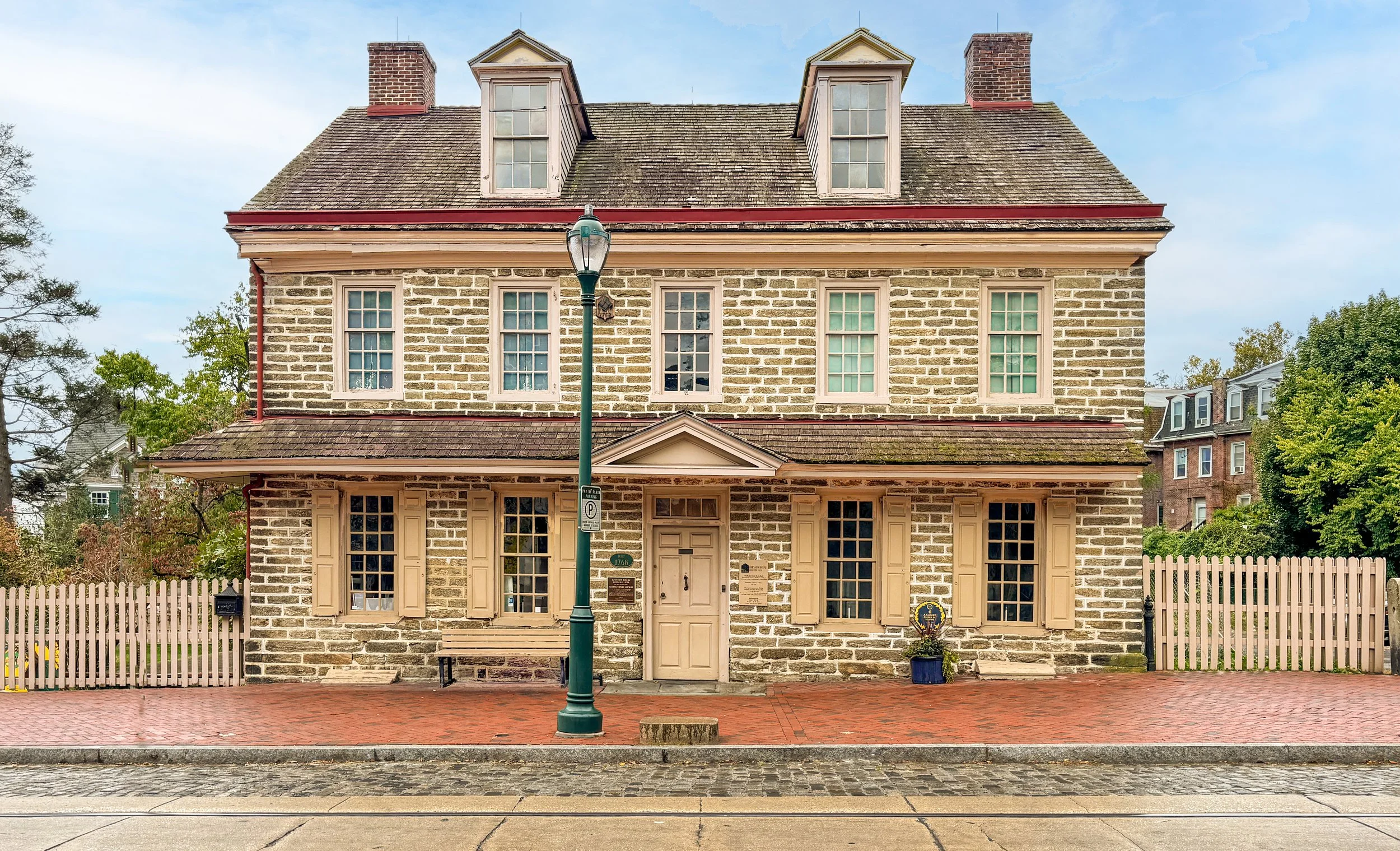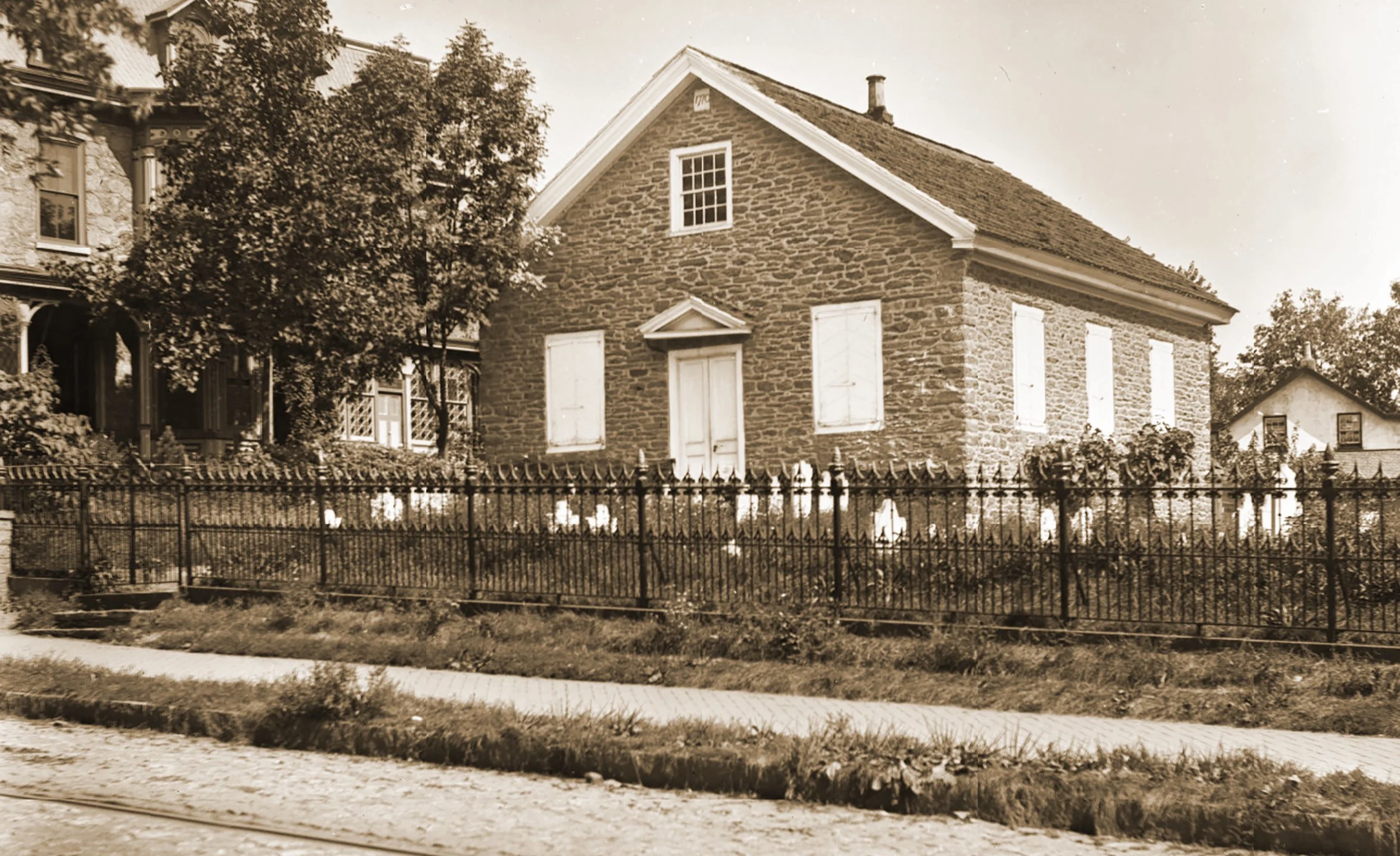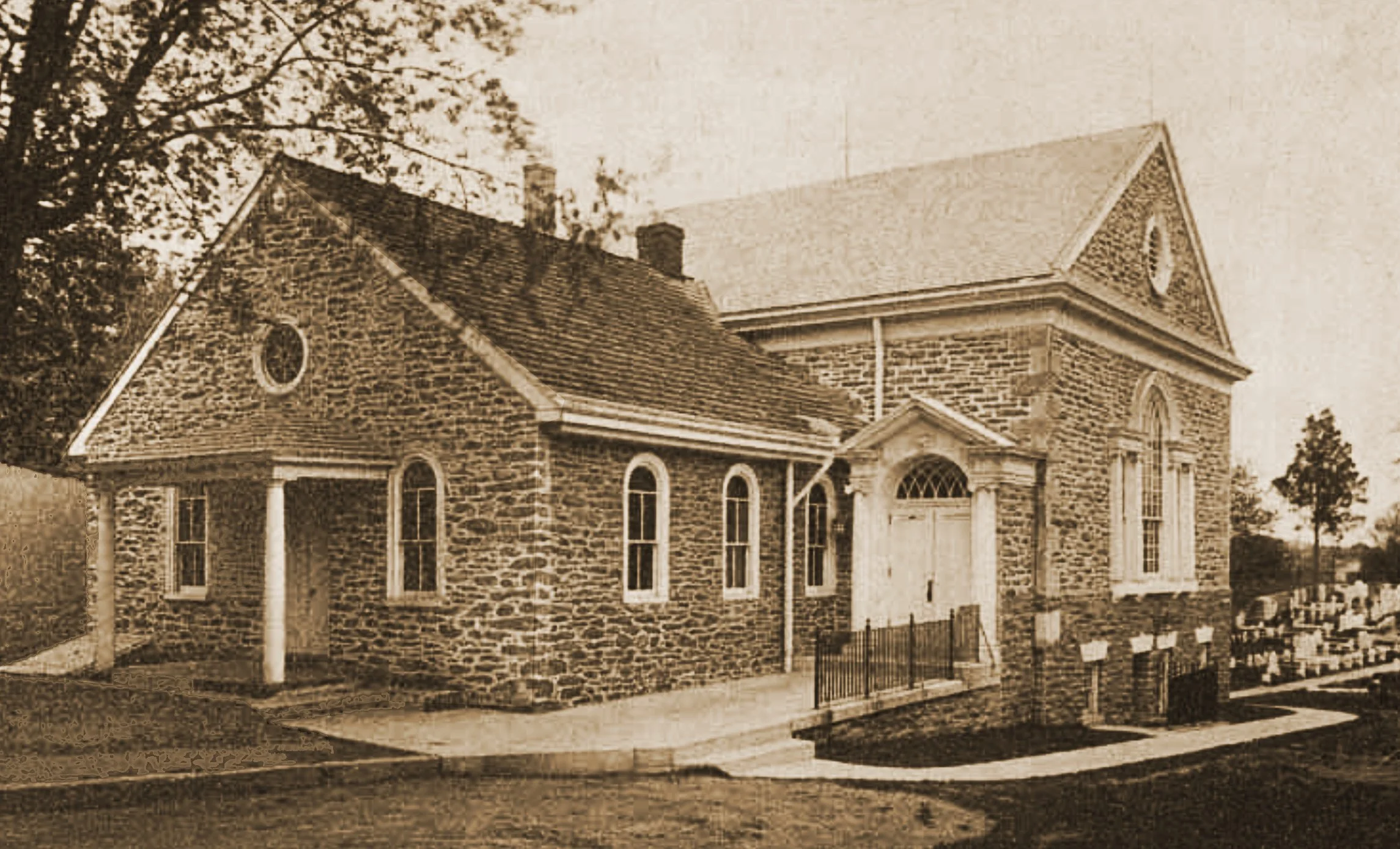Historic Quaker Houses of Philadelphia
The Johnson House
6306 Germantown Ave. Germantown
Built in 1768 for John Johnson, Sr.
Above: The Johnson House in Germantown. Image source: Lee J. Stoltzfus
The Johnson House was built between in 1768 by wealthy Quaker landowner John Johnson (Jansen), Sr. (1709–1794) as a wedding present for his son, John Johnson, Jr. who married Rachel Livezey in 1770 at Germantown Friends Meeting.
Architectural clues suggest the house was constructed by Jacob Knorr, the same master carpenter who built Cliveden, another prominent home from the same era located nearby. Today, the Johnson House is considered the oldest surviving home in Germantown that was built for year-round use.
Above: A historical marker explains the site’s importance. The stonework of this front elevation is finely-cut Wissahickon schist, also known as Chestnut Hill mica stone. The ribbon pointing accentuates this rectangular ashlar. Image source: Lee J. Stoltzfus
Johnson House Measured Drawings in 1934
By the Historic American Buildings Survey:
Above: Floorplan of the Johnson House by Walter H. Poole. Image source: Historic American Buildings Survey
Above: Measured drawings of the Johnson House by Walter H. Poole. Image source: Historic American Buildings Survey
The Johnson House
A Nationally Recognized Site on the Underground Railroad:
Above: A historical marker explains the house’s importance, beneath the 1768 datestone. Image source: Lee J. Stoltzfus
The Johnson House was not only a family home but also an important stop on the Underground Railroad. The Johnsons were a prominent Quaker family who opposed slavery on religious and moral grounds. During the 1800s, members of the Johnson family risked their safety to provide shelter and aid to freedom seekers escaping slavery.
Their home became a safe haven in a network of abolitionist efforts in Philadelphia. The family's commitment to anti-slavery activism was part of a broader Quaker movement in the region. The Johnson House today stands as one of the few surviving Underground Railroad stations open to the public.
Above: The Johnson House photographed by John Moran in 1867. Two stoop benches, which no longer survive, flank the front entry. Image source: Library Company of Philadelphia
1688: Germantown Quakers’ Anti-Slavery Protest
The First Religious Protest Against Slavery in the American Colonies:
Above: Signatures on the 1688 Quaker protest against slavery: Garret Hendericks, Derick op den Graeff, Francis Daniel Pastorius, and Abraham op den Graeff. The den Graeff family was Mennonite in Germany, before turning to Quakerism. Image source: TriCollege Libraries / Bryn Mawr
The 1688 Germantown Quaker Petition Against Slavery was the first protest against slavery made by a religious group in the Thirteen Colonies. It was the first American document to advocate for equal human rights for all.
The European settlers who began building Germantown in 1683 were mostly German-Dutch Quakers from Krefeld, a city in the lower Rhine Valley region of present-day Germany. Krefeld was under Dutch influence and control at that time. Many of the original settlers had been Mennonite before becoming associated with the Quakers. These first settlers were familiar with the Dutch language and with the Low German dialect, Krefelder Platt.
Gradually over the next century Quakers became convinced of the essential wrongness of the institution of slavery. Many of the Quaker abolitionists published their articles anonymously in Benjamin Franklin's newspaper. In 1776 a proclamation was written by Philadelphia Yearly Meeting banning the owning of slaves.
Germantown:
An Epicenter of Historic Peace Churches
Quakers, Mennonites, and Brethren
Birthplace of Mennonites and the Brethren in America:
Above: The Mennonite meetinghouse in Germantown, built in 1770. The congregation’s 1708 log meetinghouse was the first Mennonite church in America. Image source: Library Company of Philadelphia
Above: The Brethren meetinghouse in Germantown, built in 1770. It is the first Brethren church building in America. Image source: Brethren.org
Peace Church: Mennonites: Germantown is the birthplace of the Mennonite Church in America. That community is home to the first permanent Mennonite settlement in the New World. The first congregation was organized in Germantown in 1708. Mennonite arrived here as part of the original 1683 settlement. Germantown is also the first organized settlement of Germans in the colonies.
Peace Church: Church of the Brethren: The first Brethren congregation in the U. S. was founded in Germantown in 1723. Today Germantown Church of the Brethren is considered the denomination’s mother church. It is the oldest continuously existing congregation in the Brethren movement.
Historical Marker for Peace Churches
Quakers, Mennonites, and Church of the Brethren
At the Friends Center in Philadelphia:
Above: Image source: Brethren Revival Fellowship
This historical marker commemorates the legacy of Civilian Public Service (CPS) during World War II. The sign honors the more than 12,000 conscientious objectors who chose alternative service rather than military combat. This anti-war stance reflected the commitment to peace and nonviolence by Quakers and other Peach Church denominations such as Mennonites and Brethren.
The marker highlights the essential work performed by these individuals in camps and hospitals across the nation. CPS made important contributions in mental health institutions, forestry, and public health, often under the auspices of Quaker organizations such as the American Friends Service Committee.
The Friends Center in Philadelphia, with its heritage of social justice advocacy, provides a fitting location for this tribute. The sign underscores Philadelphia's historic role as a center for pacifist action and conscientious objection.
Cliveden House for an Anglican Judge
by Mennonite Carpenter Jacob Knorr
Who Also Built the Johnson House:
Above: Cliveden in Germantown, constructed by Jacob Knorr while he was building the Johnson House in the 1760s. Image source: Lee J. Stoltzfus
Mennonite preacher / carpenter Jacob Knorr constructed both the Johnson House and Cliveden in the 1760s. Cliveden is the most architecturally ambitious Georgian house in Germantown. Knorr also built the Germantown Mennonite meetinghouse in 1770.
Judge Benjamin Chew built the house as a summer residence for his family. His father, Dr. Samuel Chew, was a Quaker who left the Society of Friends after he advocated military action, a stance that conflicted with the Quakers’ commitment to pacifism.
Benjamin Chew, was Anglican. So when he built Cliveden he was not restricted by Quaker ideals of architectural plainness and simplicity. The Chew house is a showcase of high-style Georgian design.
Cliveden’s rooftop urns and paired pediments would have been excessively ornamental for most Quaker sensibilities. But they were just right for an Anglican judge like Benjamin Chew.
The Germantown Mennonite Meetinghouse
Built in 1770 by Jacob Knorr
Builder of the Johnson House and Cliveden:
Germantown, Philadelphia: The birthplace of Mennonites in America. Image source: Lee J. Stoltzfus
This Mennonite church building was built by Jacob Knorr, a local master builder. He had recently, in the 1760s, completed the Johnson House, Cliveden, and the Germantown Academy. That same year, 1770, Knorr joined this Mennonite meeting and was ordained as a minister.
Links:












